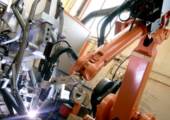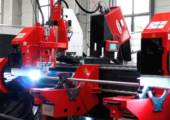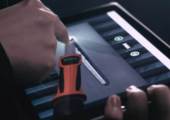-


在线留言
发送您的问题或需求,我们将尽快与您取得联系!
×
-
COMPLEX FORMS - QUICK WELD SEAMS
HOW PROCESS CONTROL VARIANTS ARE REVOLUTIONIZING THE WELDING OF EXHAUST COMPONENTS
07/27/2020
Even though electric vehicles are becoming increasingly popular in the automotive industry, analysts predict that by 2025, more than two thirds of all vehicles sold will still be powered exclusively by combustion engines. When hybrid vehicles are taken into account, the large majority of vehicles in future will still need exhaust components. Reason enough to consider how best to weld them.

The components of exhaust systems are made from a broad spectrum of parent materials – from low- and high-alloy steels to nickel-based alloys. Wall thicknesses range from a few tenths of a millimeter up to several millimeters. Manufacturing tolerances must also always be taken into account. Nevertheless, the joints must always meet exacting quality criteria – and be cost-effective to produce at the same time.
VARIED CHALLENGES – DIFFERENT COMPONENTS
Exhaust systems draw combustion gases from the engine and clean them. During this process they must withstand both high temperatures and corrosion. The demands placed on the individual components determine which material they should be made from. For example, the exhaust manifold is flange-mounted directly to the engine block. It collects the hot combustion gases that are created in the cylinders and guides them to the exhaust system. The highest temperatures are found here, and for this reason, exhaust manifolds are usually made from steels containing chrome. The component geometry is complex, with tight radii in many places – a challenge for joining technology.
Automated metal active gas welding (MAG) welding is the process most often used to join exhaust components. The exhaust manifold is particularly challenging for the welding process: the tight component radii force the robot to reduce the welding speed. Nevertheless, the amount of energy directed into the component must be kept to a minimum and the welding process must remain stable and reproducible.
HIGH-EFFICIENCY ELECTRONICS OPEN UP NEW POSSIBILITIES
Just like the exhaust manifold, other components also bring their own challenges. The type and thickness of the material used is based on the demands placed on the corresponding component group – for this reason, the welding process must also be adapted to suit the respective components. Fronius has a range of different process control variants for MAG welding that make it possible to consistently weld complex components. The high-performance electronics of modern power sources allow users to adapt the arc in a controlled manner and therefore achieve optimum results.
The Low Spatter Control (LSC) process variant is particularly suited to welding exhaust components. Based on a dip transfer arc, it is both energy-efficient and spatter-free. This is achieved by the welding system precisely controlling the short circuit: The power source accurately detects the wire electrode approaching the weld pool and regulates the detachment of the droplet into the weld pool in such a way that it happens at a lower power. This means that the heat input into thecomponent is low and almost no spatter is created. This is ideal for joining components with small wall thicknesses and variable joint geometries – such as on exhaust manifolds. In addition, LSC ensures high stability during the difficult reorientation of the welding torch and therefore high welding speeds.

A further process variant is “Pulse Multi Control,” also known as PMC. This modified pulsed arc is characterized by precisely regulated and low-spatter droplet detachment. PMC creates a powerful, stable arc, and, for example during out-of-position welding, offers high deposition rates and good controllability of the weld pool at the same time. Users can therefore avoid imperfections such as undercuts and weld in a stable and reproducible manner. This variant is particularly well suited to components that are subject to tolerances and have severe variations in wall thickness – conditions which apply to a number of exhaust components. Even in these situations, PMC ensures sufficient penetration and a gap-bridging ability. Automotive suppliers regularly use this process to weld exhaust manifolds. In practice, PMC enables the use of considerably higher welding speeds, thus increasing productivity.
HIGHER, FURTHER – THINNER!
However, the challenges the automotive industry may face in the future could shift the focus onto other process variants. A significant trend in the industry is the development of increasingly lightweight vehicles. The lower weight reduces fuel consumption, while the material savings also reduce the manufacturing costs. This also affects the design of exhaust components. The temperature-resistant parent materials and filler metals used allow the components to be manufactured from increasingly thinner materials. Components with wall thicknesses of 0.8 millimeters could therefore become standard in the future. The CMT (Cold Metal Transfer) process is often used for this type of application. The process combines a regulated dip transfer arc with a wire electrode that moves forwards and backwards. The result is a particularly low heat input and an incredibly stable welding process, which even allows users to achieve optimal results when welding very thin components.
-


 下载
下载
 会员中心
会员中心



 收起
收起























